.jpg)
Volkswagen ID.4 Review
.jpg)
Introduction
The Volkswagen ID.4 certainly turns heads. Its looks may divide opinion - it appears bulky and bulbous after all - but this gives it a presence and leaves other similarly sized SUVs looking just a little bit weedy.
All-electric cars somehow seem to look a bit different to their petrol-headed cousins. There's nothing specific you can put your finger on, but you just know that it's different. The ID.4 obliges perfectly with a modern and sporty look that's seemingly at odds with its own girth.
It nevertheless pulls it off quite well. It has stylishness in abundance, although whether it’s pretty is up for debate - beauty truly is in the eye of the beholder.
Select's rating score* - 3.9 / 5
At a Glance
We suspect some won’t appreciate the new design philosophy, which has left VW’s more modest family-themed aesthetic firmly in the past.
The back is a bit fiddly and has something of a concertina look from some angles, with the focal points being an LED light strip that spans the entire width of the boot lid. The spoiler overhanging the back window adds to the aggressiveness of the look.
At the front, there are day-running lights - likewise, the lights run, via another LED strip, along the whole of the front of the car, situated between the bonnet and the grille.

The bonnet is very big - to the point you imagine Volkswagen has shoehorned in a thumping great V8 engine - which of course it hasn't.
Alloy wheels come as standard (the size is dependent on the trim level you select), and you can choose a pleasantly contrasting bodywork shade along the pillars, which looks good against the main colour of the car.
Key Features
Although this is an SUV, the ID.4 is actually a crossover, based on the smaller hatchback ID.3.
This should, in theory, give it the drivability of a hatchback with the practicality of an SUV - and it walks the tightrope between the two reasonably well.
There are four trims on offer: Life, Style, Family and Max. Plus, there are four powertrains to select: the 145PS 'Pro' electric motor, the 148PS 'Pure', the 150PS 'Pure Performance', or the 204PS 'Pro Performance'. As you'd expect, you get a better motor as standard the higher up the trim levels you go.

All trims come with an impressive bunch of features, including keyless entry and keyless start, a rearview camera, heated front seats, adaptive cruise control, emergency brake assist and the Discover Pro infotainment system with a 10-inch touch screen.
Style adds in three-zone climate control, Family adds a panoramic glass roof, and Max sprinkles a head-up display and a larger 12-inch infotainment screen on top.
As for the exterior colours, sadly, even with nine to choose from, the selection is somewhat lacking. It is pretty much all black, white, blue and grey, or a limited combination of these. There are only a couple of interior colours to choose from - ‘Soul Black’ (which sounds ominous) and ‘Soul Black-Florence Brown’ (which sounds confusing). And you also have to select particular trim and bodywork shades to get the privilege of choosing the interior colour at all.
The wheels are 18, 19, 20 or 21-inch alloys depending on the trim level, so there’s a selection to suit those who prioritise sportiness over comfort, and vice-versa.
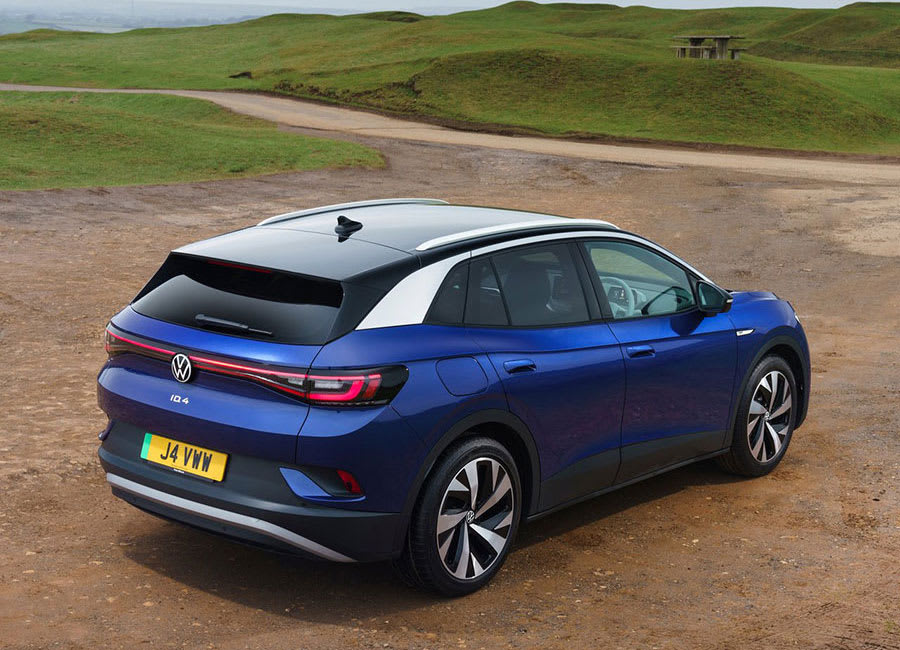
Range & Batteries
There is a choice of two batteries - 52 and 77kWh. The claimed range increases from 213 to 322 miles, depending on which one you opt for.
The range on the bigger battery beats most of the VW ID.4’s rivals, with Peugeot’s e-2008 offering a maximum of 206 miles, and Kia’s e-Niro topping out at 282 miles.
Performance & Drive
With an amply bulbous look, the car does appear as though it’s eaten one or two more burgers than it should have done, and this is reflected in the weight - it's over 2.1 tonnes.
Despite this, 0-60mph is dealt with in around 8.5 seconds in the mid-range 204PS version, which is fine for a vehicle of such magnitude. We were pleasantly surprised, although it does feel a little restrained when offering up the clout. Instead of the instant burst of energy we’ve come to expect from electric vehicles, it feels like the power is given to you gradually. This improves the comfort under acceleration but may disappoint those who like to launch themselves off from a standing start.
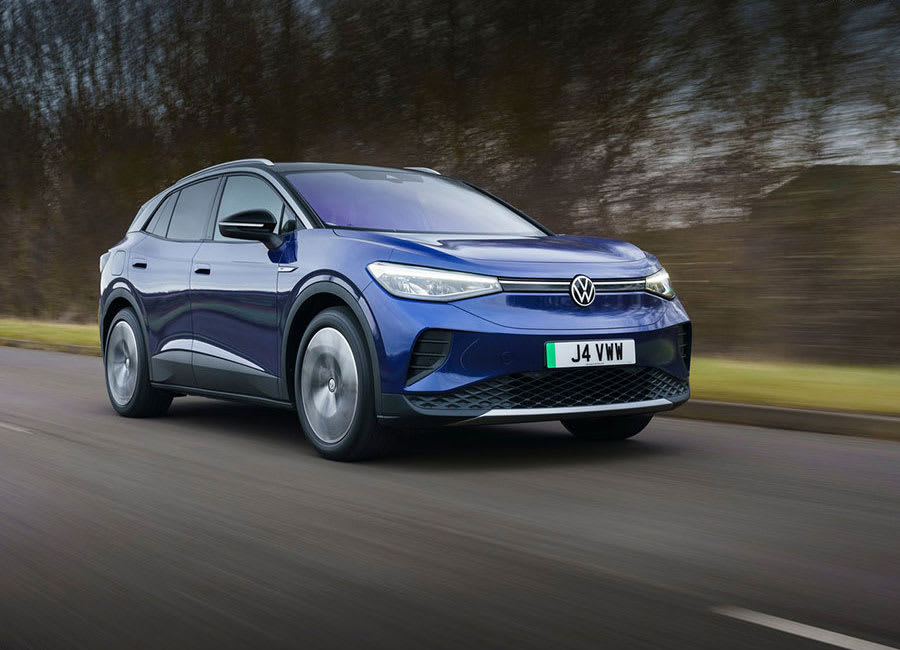
The 20-inch alloys on our test model mean the ride feels a little firm at lower speeds, but this is less noticeable the faster you go, with the seats adding to the comfort. Even with the 21-inch wheels, the ride comfort is better than you would expect.
It stops well, too, with excellent braking, while the steering feels effortless, if a little bit disconnected for those that enjoy the natural feel of a car's handling. In truth, though, if handling is your priority, then you're unlikely to be buying a mid-sized all-electric SUV.
Despite its size, Volkswagen has done a good job at lowering the centre of gravity, so there's not as much body roll in the corners as you'd expect, and this makes the car feel well planted on the road.
The VW is well soundproofed with low road and wind noise. That said, if you're not used to driving electric vehicles, you'll probably disagree with this, as any noise is noticeable when there’s no engine note to drown it out. Nonetheless, as far as electric cars go, VW has done a fine job.
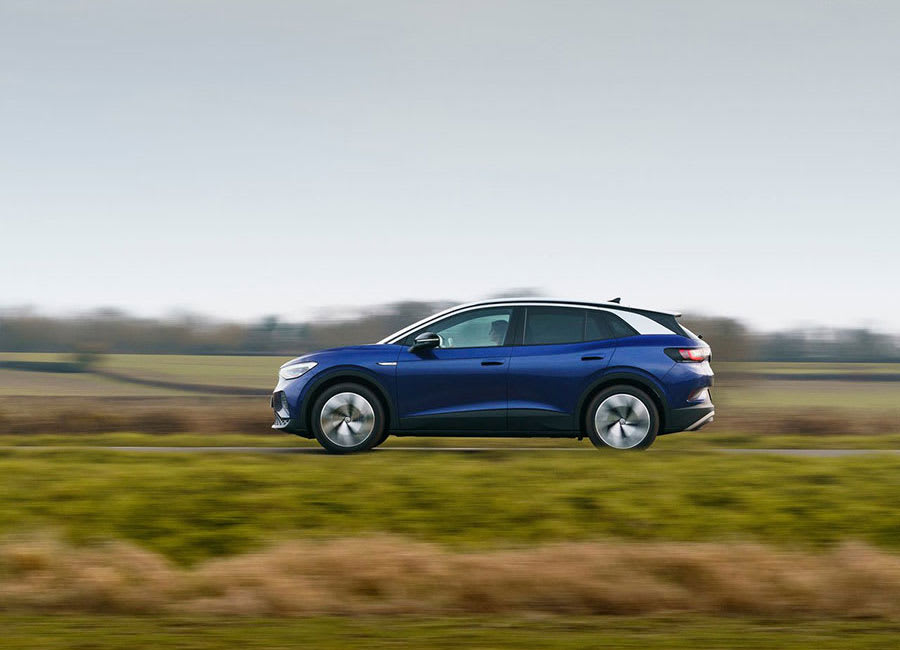
The ID.4 features four driving modes: Eco, Comfort, Sport and Individual. Each gives you a sliding scale of performance versus economy. The latter setting is customisable to your preferred setup, adjusting the steering, acceleration and powertrain management, and even the dampers.
Overall, Volkswagen has done wonders with the driving experience, bettering its nearest rivals such as the Kia e-Niro and the Peugeot e-2008.
Charging
The ID.4 range comes with two batteries to choose from - 52 and 77kWh.
The range-topping 77kWh battery will take over a day to fully charge on a regular household plug. But, with a dedicated charging box on the wall, you can decrease that to around ten hours, depending on how much juice the box can provide.
Larger roadside chargers will be able to provide 0-80% of battery life in under an hour.
Running Costs & Emissions
The smaller battery is available with 148 or 170bhp electric motors, although we don't much recommend either given the car's weight.
The bigger battery comes with 204bhp, with is far more adequate.

The ID.4 comes with a basic three-year warranty - or 60,000 miles, whichever comes first. There is, however, a separate eight-year/100,000 miles warranty for the batteries.
With no liquid fuel, you don't need to worry about CO2 emissions. But, if you're environmentally conscious and want to know how green the manufacturing process is, VW has been a leader in this field - the ID.4 is independently verified as carbon neutral. Volkswagen even plants trees to offset the carbon emissions during the vehicle's production.
Interior & Technology
The interior looks futuristic, albeit the designers have weighed quite heavily on minimalism. With very few buttons and switches, this will suit those who prefer a simplistic layout.
Except for the steering wheel, that is. Volkswagen seems intent on building in futuristic touches for the sake of it, none of which make it any easier to use. Firstly, the cream steering wheel looks nice. But it's an entirely different colour from the rest of the interior, so it seems odd. Clearly, VW has tried to give its all-electric range some sort of signature to show that it's 'other worldly’, but it all looks a bit out of place unless the rest of the interior is the same colour, which it isn’t.

Secondly, the simplistic interior unravels when you realise you have to run your finger along a touch-sensitive bar to turn the cabin temperature up and down. Sounds cool, looks cool - but not actually that cool when you're driving along at 70mph. This being the future, you can, of course, simply raise your voice and literally ask the car to turn its temperature down for you, but this often doesn’t work for reasons we’ll explain later.
Thirdly, while it’s great it has four electric windows, the method of controlling them from the driver’s side is most bizarre, as there are only two switches. You have to ‘toggle’ between the rear and front windows by pushing a button. And, again, it’s not great to need to take your eyes off the road to see which window you’re controlling when you’re doing 70mph. Surely you’d just put four switches in?

And, fourthly, speaking of buttons, the reason for the lack of them in the usual places seems to be because most of them have been moved to the steering wheel, which provides excessive complication.
You also change gear with a switch behind the steering wheel, which would be fine were the wheel itself not too cluttered with buttons that couldn't find a home elsewhere.
All that aside, the interior is pleasant, although while there are padded surfaces, there are also the inevitable cheap plastics. For the car's asking price, we expected there to be fewer of these.
It is a shame that the lack of practicality for the driver ruins what is otherwise a fine, very impressive interior. It’s classy, attractive and comfortable and will impress passengers. It’s just a shame that it’ll be ruined by the steam coming out of the infuriated driver’s ears.
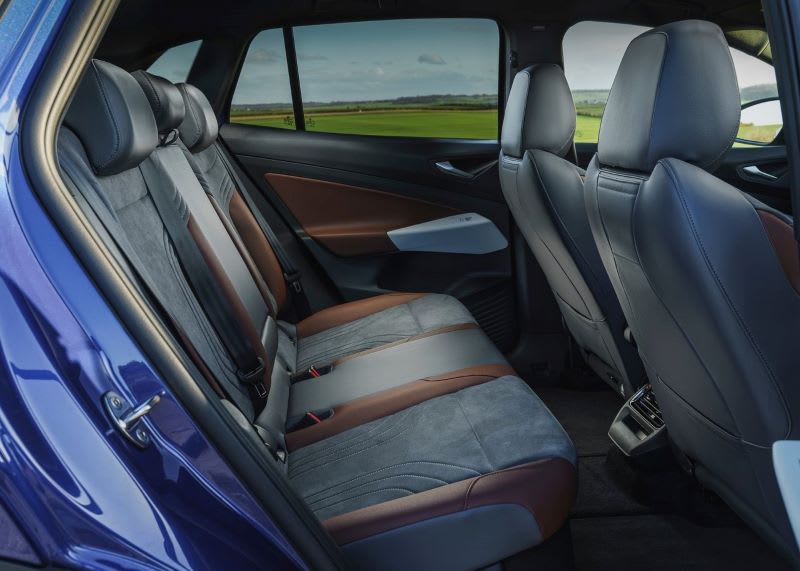
A strip of LEDs below the windscreen is a nice touch as, if you’re following the SatNav, they will subtly point in the right direction of where you need to go, so you don't even need to look at the screen.
The infotainment system is not a class leader, but it’s simple enough to use and has customisable displays, so you can choose what icons you want and where, although this does have its limitations. Nevertheless, everything you’d expect is there, from music, radio, vehicle information and SatNav, as well as Apple CarPlay and Android Auto integration.
Our test model included voice control, so you can, in theory, talk to the car and tell it what you want it to do, although there were occasions where it didn’t quite understand us.
Practicality & Boot Space
The car has an impressive amount of storage space inside, with the centre console offering two storage bins, one of which has a removable double drinks holder.
There are USB charging ports, wireless charging is available, the door pockets have plenty of room, and there are even retractable armrests. The glove box is a bit on the small side, but we can live with that.
The VW’s interior is spacious, with plenty of legroom in the back, while all but the tallest of passengers will find the headroom plentiful. And, with no prop shaft tunnelling underneath the car, the rear floor is flat, making it easier to accommodate the feet of three back seat passengers.
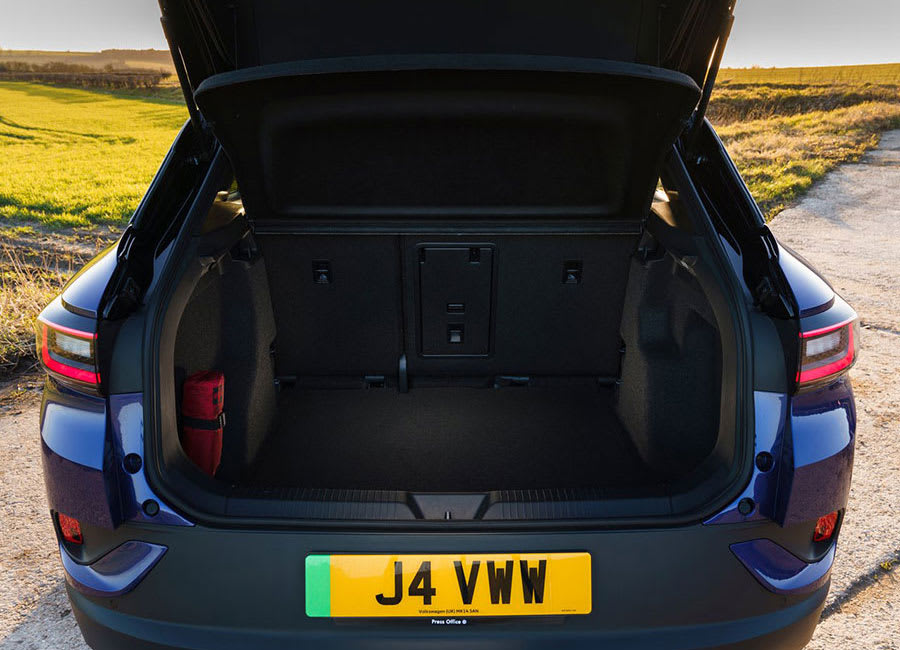
Electric tailgates are becoming increasingly common, but the VW is still manually hand-operated, unless you pay extra or choose the range-topping trim. It does open to reveal a more-than-adequate 543-litres of boot space, though, increasing to 1575-litres with the rear seats folded. That is bigger than the Kia e-Niro, the Mustang Mach-E, and the Polestar 2.
Safety
The ID.4 has been crash-tested by Euro NCAP and performed admirably, with a five-star rating. Breaking this down reveals a 93% safety rating for adult occupants and 89% for child occupants.
Nobody wants to think about being involved in a high-speed crash. Still, the videos on Euro NCAP's website reassuringly show a hefty head-on shunt that leaves the passenger cabin remarkably intact, with the front-end absorbing all the impact and, crucially, damage.
Safety features include automatic emergency braking, so whilst someone pulling out in front of you won’t be any less annoying, you will at least avoid crashing into them. The system will also apply the brakes if a pedestrian runs into the road in front of you.
Lane-keep assist will stop you from straying into oncoming traffic or accidentally moving across into the next lane on motorways. It will also prevent you from brushing the barriers if you stray too far over in the outside lane.
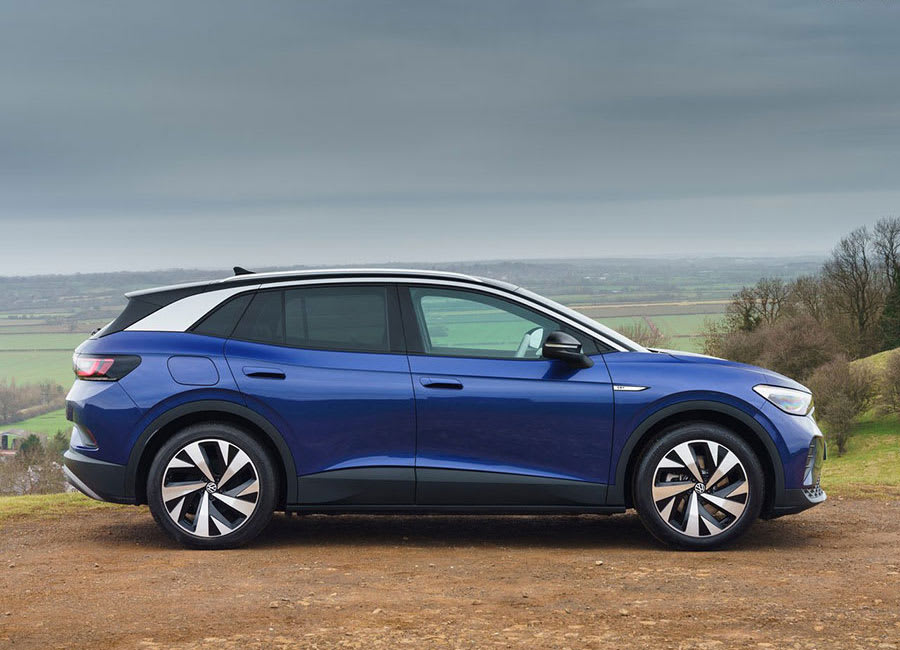
Options
The infotainment system can be upgraded, giving you an improved SatNav system, bigger 12-inch screen, wireless smartphone charger and a head-up display, although this comes as standard on the range-topping Max.
Sports options are available, too, which improve chassis control and rear-shock absorption.
The ‘Assistant Package Plus’ provides an electric tailgate amongst other accessories, which, again, are included as standard on the range-topping Max trim.
There is also a heat pump that can warm the cabin quickly, using less power, so that's useful if you're likely to be using the car on freezing winter mornings.
Added to that, there is a glut of accessories available, from mudflaps to sunblinds and roof boxes to bicycle holders.

Rival Cars
Other alternatives worth considering include the Kia e-Niro, which has similar performance for less money, the Peugeot e-2008, Volvo’s XC40 Recharge, Ford’s Mustang Mach-E and the Polestar 2.
Of course, you can't really mention electric vehicles without bringing Tesla into the equation. But Tesla’s ID.4 equivalent, the Model X, is literally in the realms of twice the price.
VW’s own smaller ID.3 could be an alternative, too. It provides a better overall driving experience for less cost and greater range, but it isn’t as spacious as the ID.4. It’s certainly worth considering if you’re not entirely sold on the SUV idea.
Verdict & Next Steps
Overall, the ID.4 is an excellent all-rounder. It has recently won World Car of The Year 2021, and we can see exactly why.
It may not win the beauty pageant, nor will it win awards for the exuberance of its driving performance, but then nobody is buying an SUV crossover for such purposes.
SUVs are a complex blend of comfort versus drivability, and VW has done a superb job to satisfy these two contrasting categories.
The car is practical, and, if you can get your head around the annoyances with the buttons, touch-sensitive switches, and the like, then you’re literally on to a winner.
We wish VW had spent more time on the usability of the tech inside, rather than trying to wow us with fiddly, touch-sensitive toggly buttons. But hopefully, there'll be a rethink of the layout for its mid-life facelift in a few years' time.
Nevertheless, ID is short for ‘Intelligent Design’ and, buttons and switches aside, VW has used its intelligence very wisely.
The ID.4 is a strong candidate for the here and now if you're thinking of moving into the electric car market and you need something roomy, safe and comfortable for the whole family.
Where to next?
View latest VW ID.4 leasing deals - guide price from ££385.19 per month inc VAT**
Looking for a great deal? Check out our incredible range of car lease deals
New electric SUV? Read our latest Reviews and find the right model for you
Want to know more about leasing? Take a look at our comprehensive Leasing Guides
Interested in everything motoring? Why not catch up on all the latest Car Leasing News.
*Score based on Select’s unique meta score analysis, taking into account the UK’s top five leading independent car website reviews of the VW ID.4
**Correct as of 19/04/2023. Based on 9 months initial payment, 5,000 miles over a 48 month lease. Initial payment equivalent to 9 monthly payments or £3,466.71 Ts and Cs apply. Credit is subject to status.
{ "@context": "http://schema.org", "@type": "VideoObject", "name": "Volkswagen ID.4 Review - Select Car Leasing", "description": "This week, we took the Volkswagen ID.4 for a spin – the firm's first ever fully-electric SUV. The VW ID.4 is a big brother to the smaller ID.3, and comes built for busy families, with 543 litres of luggage space and an equipment range that includes an electrically-driven boot lid, roof railings and a towing bracket. Next up, we’re got the BMW i4 to check out to ⚡ Stay tuned. To lease the VW ID.4 with us today, click this link 👉🏻 https://www.selectcarleasing.co.uk/ca... #carreview #carreviews #electriccars #electricvehicles #selectcarleasing #leasing #volkswagen #vw #vwid4 #id4 #compactsuv #SUV #ElectricSUV @thesustainabledad @generatemedia_ #fullyelectric #generatemedia #sustainabledad #sustainable #electric #travel Sections: 00:00:00 - Intro 00:00:13 - First impressions / Exterior 00:00:42 - Boot open 00:00:59 - Charging access 00:01:04 - ID.4 vs ID.3 00:01:21 - Boot space 00:01:38 - Turning circle 00:01:55 - First impressions, speed and range 00:02:14 - Interior elements 00:03:12 - The drive 00:03:27 - Re-gen braking 00:03:49 - That sound 00:04:00 - Overview / Summary", "thumbnailUrl": "https://i.ytimg.com/vi/mufKx-J-Q6s/hqdefault.jpg", "uploadDate": "2022-11-18T07:04:32-08:00", "duration": "PT4M22S", "embedUrl": "https://www.youtube.com/embed/mufKx-J-Q6s", "contentUrl": "https://www.youtube.com/watch?v=mufKx-J-Q6s", "interactionCount": "10285" }


















